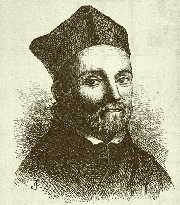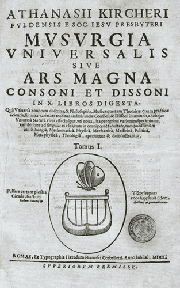|

Athanasius Kircher

Athanasius
Kircher, Musurgia universalis, sive Ars magna consoni et dissoni
in x. libros digesta, Roma 1650, frontispiece.
|
Born at Geisa, in Germany, he
entered the Society of Jesus in 1616. He first read mathematics and
philosophy at Würzburg, then moved to Avignon, then lastly to
Rome, where, around 1638, he was called upon to teach mathematics
in the Collegio Romano. He was a prolific writer of European fame,
the author of many works dedicated to diverse fields of knowledge,
from philology to physics, sacred writings, astronomy, natural history,
mathematics, music, egyptology, geography and Chinese civilisation.
Among the scientific works, we should note the Magnes, sive de
ars magnetica (1641), the Ars magna lucis et umbrae (1645),
the Mundus subterraneus (1665), the Organum mathematicum
(1668) and the Musurgia universalis (1650).
In
this last work, Kircher tells of having performed an experiment which
convinced him of the impossibility of a vacuum in nature. The experiment
was conducted by Gaspero Berti and himself, consisting in the insertion
of a bell into the part of the barometer in which - according to the
"vacuists" - the vacuum should be produced. Using a magnet outside
the apparatus, they made the bell clapper move. According to the Jesuit,
the bell's sound was distinctly audible, showing the presence of air
which transferred it. A similar experiment was performed, with exactly
the opposite results, by Robert Boyle, using the air-pump. Boyle claimed
that, after the removal of air, the sound was no longer heard.
|

